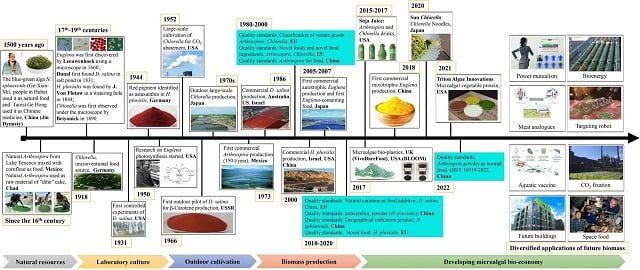
Microalgal biomass has been used since ancient times and represents a sustainable bioresource for various applications, including food, nutraceuticals, pharmaceuticals, and other bioproducts. The process of microalgal biomass production involves several techniques, mainly cultivation, harvesting, drying, and pollution control. These techniques are often designed and optimized to meet optimal growth conditions for microalgae and to produce high-quality biomass at acceptable costs.
However, microalgal biotechnology faces several challenges, particularly the high production costs, limited knowledge about biological contaminants, and the challenge of preserving active ingredients during biomass production.
Scientists from the Yantai Institute of Coastal Zone Research, Wageningen University, and China University of Petroleum (East China) published a scientific review examining the global development of microalgal biotechnology for biomass production, with a focus on cultivation, harvesting, drying, and biological contaminant control techniques.
Microalgae Production Systems
The study describes various microalgae production systems, including the key features of traditional open pond systems, photobioreactors, and heterotrophic cultivation. Researchers conduct a detailed analysis of the advantages and disadvantages of each system.
Microalgae Harvesting
Harvesting microalgae represents one of the most significant challenges for commercial-scale biomass production. Microalgae typically grow suspended in water, and even in heterotrophic cultures, microalgal biomass seldom exceeds 20% of dry weight. Therefore, harvesting requires considerable energy and capital investment, contributing to about 30% of the total production cost. The choice of harvesting method depends on factors such as the microalgae type, cell density, and the value of commercialized biomass products.
According to the scientific review, microalgae harvesting involves mechanical, chemical, electrical, and biological methods, with conventional commercial methods including centrifugation, filtration, and flocculation, either individually or in combination.
Microalgae Drying
Drying is typically the final step in harvesting, involving the removal of moisture to obtain dry microalgal biomass for product manufacturing. The study describes commercially used drying techniques, including solar drying, convective drying, spray drying, and freeze-drying. The authors emphasize that selecting the appropriate drying method is critical for subsequent processing and product quality.
Biological Contaminant Control
Ideally, microalgae cultivation involves cultivating a single species. However, it is challenging to prevent biological contaminants from entering cultures, whether in open ponds or photobioreactors. These limitations in production systems are the primary cause of biological contaminant spread. Therefore, response strategies are required to prevent them during mass microalgae cultivation. The study identifies major biological contaminants, including zooplankton, bacteria, viruses, and other microalgae.
Biotechnologically Ideal Microalgae Strains
Although there are thousands of microalgae species in nature, only a few are used for commercial biomass production. In the last decade, annual biomass production has been dominated by six species: the cyanobacteria Arthrospira and Nostoc (cultivated only in China), the green microalgae Chlorella, Dunaliella, and Haematococcus, and the flagellate Euglena. The study details the strengths, obstacles, and technologies to further improve biomass production for these identified microalgae species.
Quality Control
Microalgal biomass can be susceptible to contamination by heavy metals, mycotoxins, pathogens, and algal toxins. The industry is subject to regulations, with standards aimed at ensuring safety and quality, although improvements are urgently needed. The study summarizes key regulations in the microalgae industry.
Conclusions
“This review systematically summarizes current biomass production technologies for commercial microalgae. We conclude that high-density cell culture is essential for future commercial-scale biomass production, and cost-effective processes and strategies are required for microalgae harvesting development,” report the scientists. They emphasize the importance of cost-effective drying that considers product quality and the need for further basic research on biological contaminant control.
According to the authors of the scientific review, “It is clear that significant investments in technological development and technical expertise will be needed before broader applications of microalgal biomass can be achieved.”
Contact
Song Qin
Yantai Institute of Coastal Zone Research
Chinese Academy of Sciences
No. 19, Chunhui Road, Laishan District, Yantai, 264003
Shandong, China
Email: sqin@yic.ac.cn
Reference (Open Access)
Qin, S., Wang, K., Gao, F. et al. Biotechnologies for bulk production of microalgal biomass: from mass cultivation to dried biomass acquisition. Biotechnol Biofuels 16, 131 (2023). https://doi.org/10.1186/s13068-023-02382-4
Editor at the digital magazine AquaHoy. He holds a degree in Aquaculture Biology from the National University of Santa (UNS) and a Master’s degree in Science and Innovation Management from the Polytechnic University of Valencia, with postgraduate diplomas in Business Innovation and Innovation Management. He possesses extensive experience in the aquaculture and fisheries sector, having led the Fisheries Innovation Unit of the National Program for Innovation in Fisheries and Aquaculture (PNIPA). He has served as a senior consultant in technology watch, an innovation project formulator and advisor, and a lecturer at UNS. He is a member of the Peruvian College of Biologists and was recognized by the World Aquaculture Society (WAS) in 2016 for his contribution to aquaculture.
